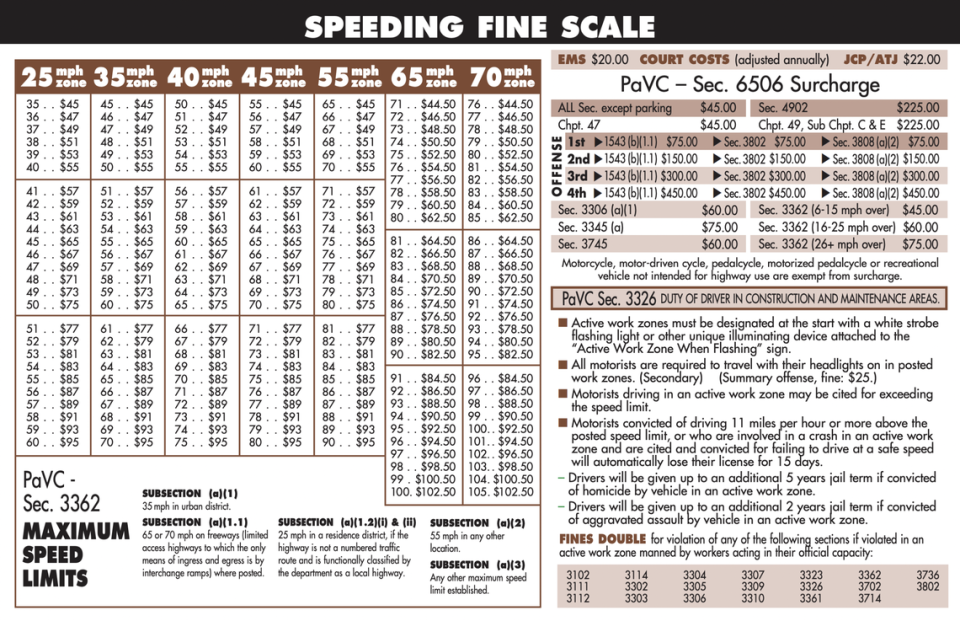Can I drive over the speed limit to keep up with traffic? What Pennsylvania law says
Can you drive above a posted speed limit to keep up with traffic or pass a slower driver? If you’re in Pennsylvania, the answer can get complicated.
Pennsylvania gives drivers a cushion around speed limits to avoid breaking the law, but those protections are limited in scope. Excessive speeding above a posted limit — or driving too far below — can result in steep fines or penalties on your driving record.
Here’s what you need to know about Pennsylvania’s law, how fast you can travel on the commonwealth’s roads and the penalties you could face behind the wheel.
What are Pennsylvania’s speeding laws?
Pennsylvania law states no one should drive a vehicle “at a speed greater than is reasonable and prudent under the conditions and having regard to the actual and potential hazards then existing, nor at a speed greater than will permit the driver to bring his vehicle to a stop within the assured clear distance ahead.”
These laws are commonly enforced through speed limits, which vary throughout the commonwealth on different types of roads and areas, like highways and schoolyards or even in construction zones. Those who break a speed limit by exceeding the posted rate can face fines and penalties for their driving records.
Notably, Pennsylvania gives drivers a small cushion around maximum speed limits if police officers are recording vehicle speeds using speedometers or other electronic devices.
“No person may be convicted upon evidence obtained through the use of [electronic devices] unless the speed is six or more miles per hour in excess of the legal speed limit,” Pennsylvania’s code reads.
That protection increases on roads with slower speed limits, according to the commonwealth’s code.
“Furthermore, no person may be convicted upon evidence obtained through the use of [electronic devices] in an area where the legal speed limit is less than 55 miles per hour if the speed recorded is less than ten miles per hour in excess of the legal speed limit.
These speed limit cushions do not apply to electronically recorded evidence of speeding within school zones or active road work zones.
What are Pennsylvania’s speed limits?
Pennsylvania law defines maximum speed limits for the following scenarios:
35 mph in any urban district
65 or 70 mph for all vehicles on freeways
25 mph in a residential district where the road is not a numbered traffic route and is “functionally classified by [a local department] as a local highway”
55 mph “in other locations”
Additional speed limits are defined for more specific scenarios, including 15 mph in an established school zone (when lights are flashing) or a posted limit on particularly steep inclines, such as mountain crossings. Active work zones along roads and highways often post reduced speed limits, and breaking those can incur additional penalties for drivers.
The commonwealth’s code gives local authorities jurisdiction to establish minimum speed limits for roads on which “slow speeds impede the normal and reasonable movement of traffic.”
Pennsylvania drivers are expected to drive near the speed limit at all times, though exceptions are available “when reduced speed is necessary for safe operation or in compliance with law.” Drivers who move their vehicles significantly below the maximum posted speed on a one-lane road while impeding the flow of traffic are instructed to pull off the highway and return “when the movement can be made in safety and so as not to impede the normal and reasonable movement of traffic,” the law states.
Can you legally use headphones or earbuds while driving in PA? See what the law says
What penalties could I face for speeding in Pennsylvania?
The most common punishment drivers could face for speeding in Pennsylvania is a fine. These can start around $45 (plus potential court costs and other fees), but they may quickly escalate if drivers are convicted for speeding to a greater degree or doing so in an area with a higher speed limit.
The PA Traffic Injury Prevention Project, funded through the Pennsylvania Department of Transportation, offers the following chart displaying the base fines for speeding in several speed limit zones. Fines on these scales, last revised in May 2023, may be coupled with additional fines and fees for drivers who are repeat offenders or are caught driving in school zones, active work zones and more.

Pennsylvania drivers can still be ticketed for driving within the posted speed limit if road conditions — such as heavy rain or snow — necessitate a slower speed, PennDOT says.
State law outlines additional penalties for drivers found speeding through more specific areas, including active work zones or on bridges and elevated structures. Drivers could face up to a $500 fine if they are caught and convicted for driving more than 11 mph above a posted speed limit in a school zone, for example.
Additionally, those convicted of speeding in these areas by more than 5 mph must pay an additional fine of $2 per mile for each mile in excess of 5 mph of the maximum speed limit.
Pennsylvania drivers convicted of speeding usually incur points on their driving records, ranging from two points for speeding between 6 and 10 mph above a posted speed limit to five points if found speeding more than 31 mph above the posted rate.
Licenses are automatically suspended when any record reaches 11 points, and the suspension’s length is dependent upon prior offenses. A first-timer receives five days of suspension per point, while someone who has had their licenses suspended at least three times could face more than a year for a subsequent offense.

